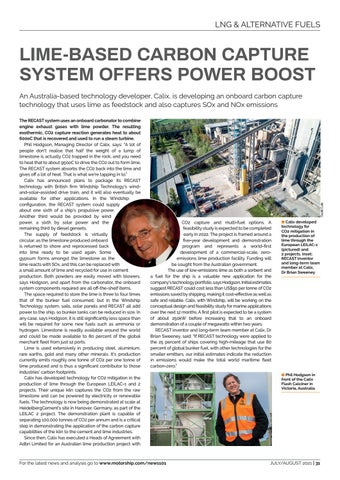LNG & ALTERNATIVE FUELS
LIME-BASED CARBON CAPTURE SYSTEM OFFERS POWER BOOST The RECAST system uses an onboard carbonator to combine engine exhaust gases with lime powder. The resulting exothermic, CO2 capture reaction generates heat to about 600oC that is recovered and used to run a steam turbine. Phil Hodgson, Managing Director of Calix, says: “A lot of people don't realise that half the weight of a lump of limestone is actually CO2 trapped in the rock, and you need to heat that to about 950oC to drive the CO2 out to form lime. The RECAST system absorbs the CO2 back into the lime and gives off a lot of heat. That is what we're tapping in to.” Calix has announced plans to package its RECAST technology with British firm Windship Technology's windand-solar-assisted drive train, and it will also eventually be available for other applications. In the Windship configuration, the RECAST system could supply about one sixth of a ship's propulsive power. Another third would be provided by wind power, a sixth by solar power and the remaining third by diesel gensets. The supply of feedstock is virtually circular, as the limestone produced onboard is returned to shore and reprocessed back into lime ready to be used again. Some gypsum forms amongst the limestone as the lime reacts with SOx, and this can be replaced with a small amount of lime and recycled for use in cement production. Both powders are easily moved with blowers, says Hodgson, and apart from the carbonator, the onboard system components required are all off-the-shelf items. The space required to store the lime is three to four times that of the bunker fuel consumed, but in the Windship Technology system, sails, solar panels and RECAST all add power to the ship, so bunker tanks can be reduced in size. In any case, says Hodgson, it is still significantly less space than will be required for some new fuels such as ammonia or hydrogen. Limestone is readily available around the world and could be made available to 80 percent of the global merchant fleet from just 12 ports. Lime is used extensively in producing steel, aluminium, rare earths, gold and many other minerals. It's production currently emits roughly one tonne of CO2 per one tonne of lime produced and is thus a significant contributor to those industries' carbon footprints. Calix has developed technology for CO2 mitigation in the production of lime through the European LEILAC-1 and 2 projects. Their unique kiln captures the CO2 from the raw limestone and can be powered by electricity or renewable fuels. The technology is now being demonstrated at scale at HeidelbergCement's site in Hanover, Germany, as part of the LEILAC 2 project. The demonstration plant is capable of separating 100,000 tonnes of CO2 per annum and is a critical step in demonstrating the application of the carbon capture capabilities of the kiln to the cement and lime industries. Since then, Calix has executed a Heads of Agreement with Adbri Limited for an Australian lime production project with
Credit: Calix
An Australia-based technology developer, Calix, is developing an onboard carbon capture technology that uses lime as feedstock and also captures SOx and NOx emissions
CO2 capture and multi-fuel options. A feasibility study is expected to be completed early in 2022. The project is framed around a five-year development and demonstration program and represents a world-first development of a commercial-scale, zeroemissions lime production facility. Funding will be sought from the Australian government. The use of low-emissions lime as both a sorbent and a fuel for the ship is a valuable new application for the company's technology portfolio, says Hodgson. Initial estimates suggest RECAST could cost less than US$50 per tonne of CO2 emissions saved by shipping, making it cost-effective as well as safe and reliable. Calix, with Windship, will be working on the conceptual design and feasibility study for marine applications over the next 12 months. A first pilot is expected to be a system of about 250kW before increasing that to an onboard demonstration of a couple of megawatts within two years. RECAST inventor and long-term team member at Calix, Dr Brian Sweeney, said: “If RECAST technology were applied to the 25 percent of ships covering high-mileage that use 80 percent of global bunker fuel, with other technologies for the smaller emitters, our initial estimates indicate the reduction in emissions would make the total world maritime fleet carbon-zero.”
For the latest news and analysis go to www.motorship.com/news101
8 Calix developed technology for CO2 mitigation in the production of lime through the European LEILAC-1 (pictured) and 2 projects. Inset: RECAST inventor and long-term team member at Calix, Dr Brian Sweeney
8 Phil Hodgson in front of the Calix Flash Calciner in Victoria, Australia
JULY/AUGUST 2021 | 31







